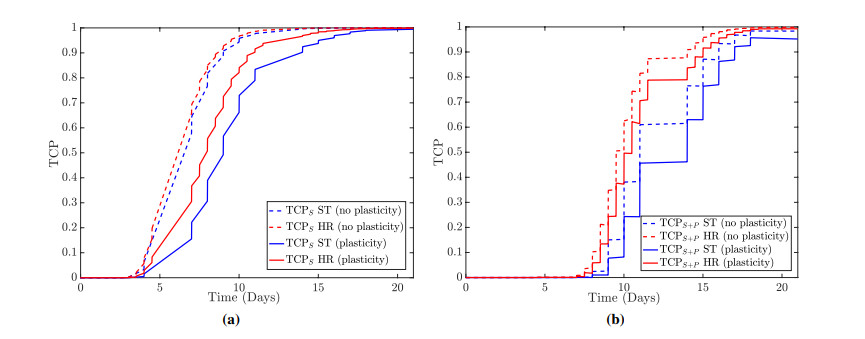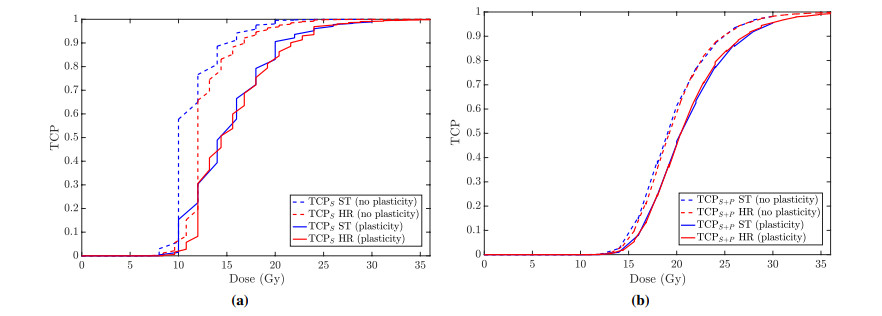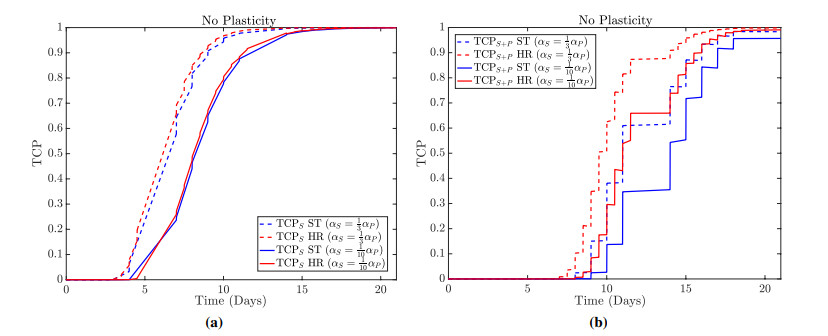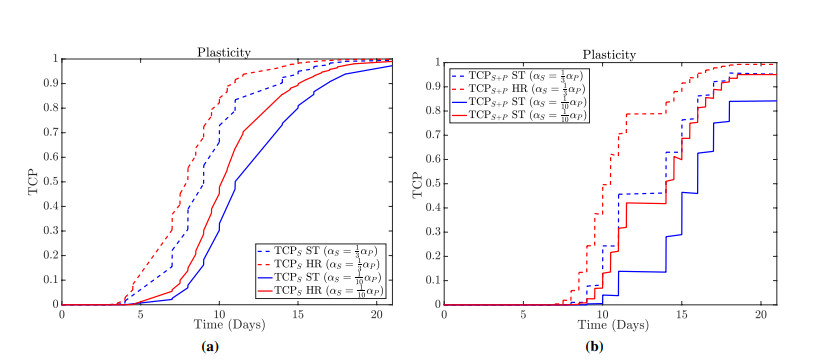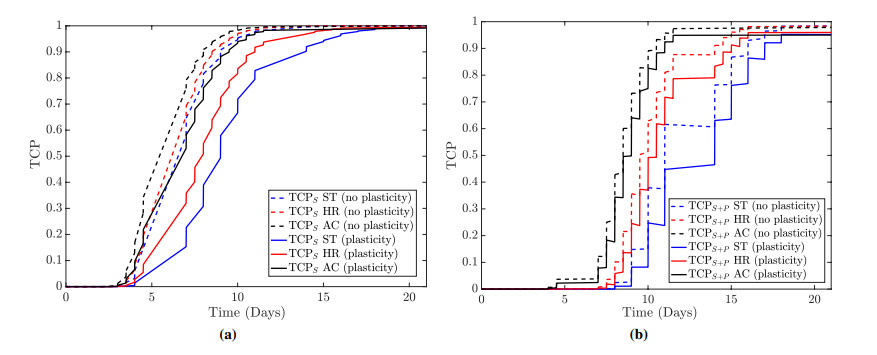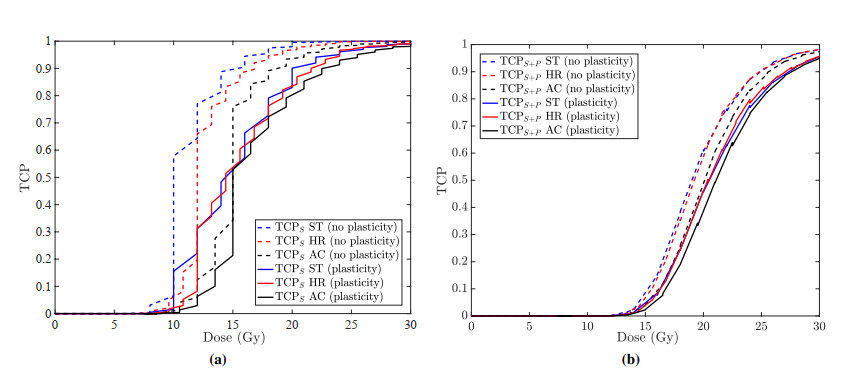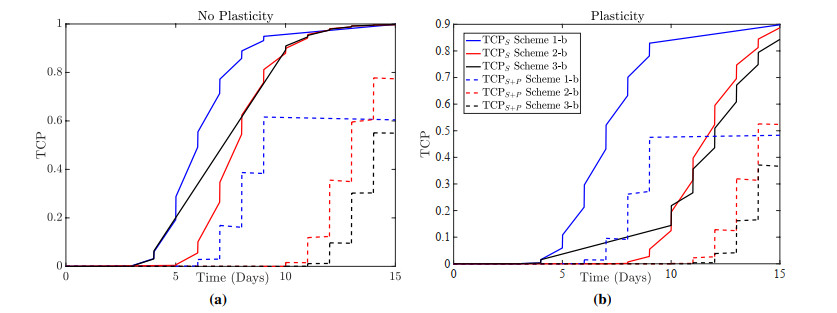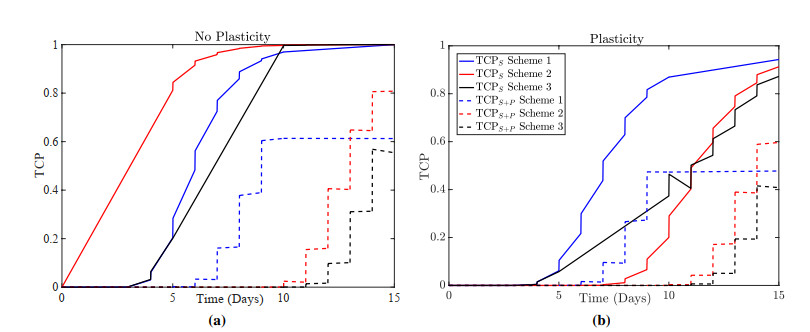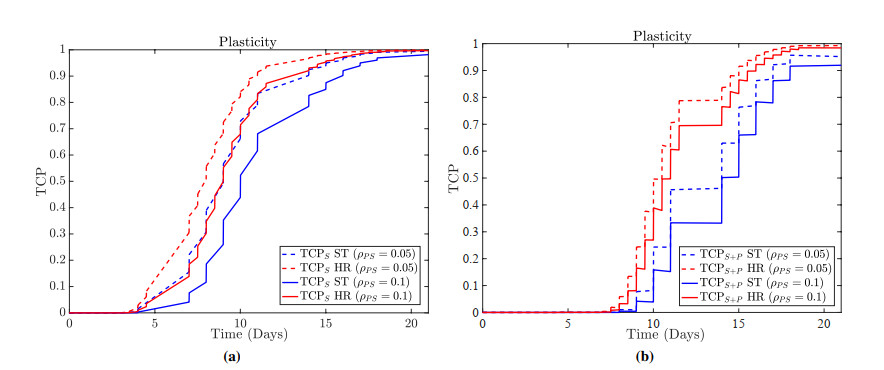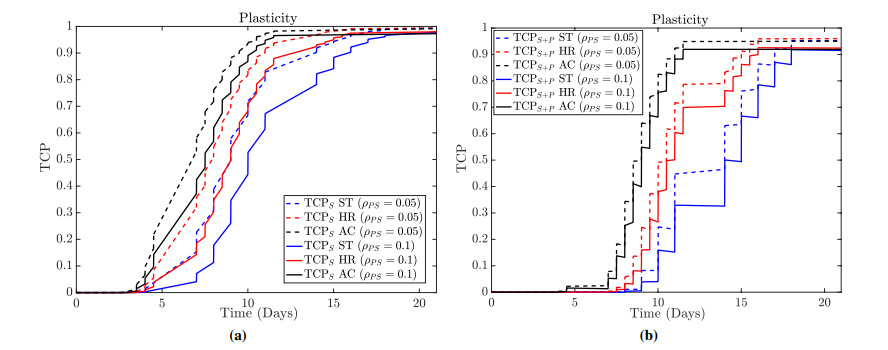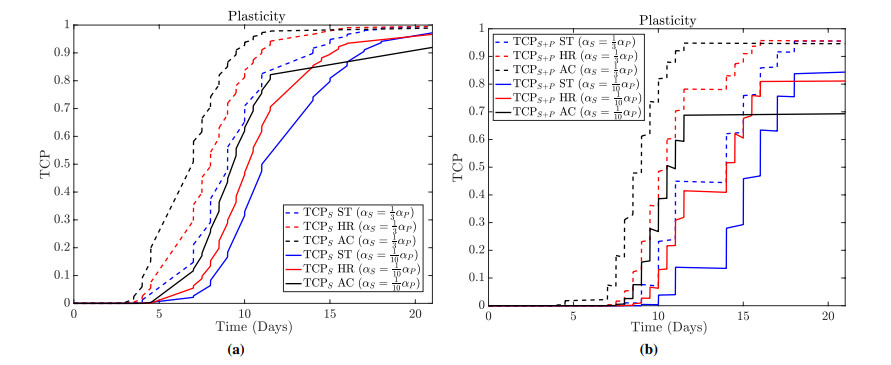Cell migration on and through extracellular matrix is fundamental ina wide variety of physiological and pathological phenomena, and isexploited in scaffold-based tissue engineering. Migration isregulated by a number of extracellular matrix- or cell-derivedbiophysical parameters, such as matrix fiber orientation, pore size,and elasticity, or cell deformation, proteolysis, and adhesion. Wehere present an extended Cellular Potts Model (CPM) able toqualitatively and quantitatively describe cell migrationefficiencies and phenotypes both on two-dimensional substrates andwithin three-dimensional matrices, close to experimental evidence.As distinct features of our approach, cells are modeled ascompartmentalized discrete objects, differentiated into nucleusand cytosolic region, while the extracellular matrix iscomposed of a fibrous mesh and a homogeneous fluid. Our modelprovides a strong correlation of the directionality of migrationwith the topological extracellular matrix distribution and abiphasic dependence of migration on the matrix structure, density,adhesion, and stiffness, and, moreover, simulates that celllocomotion in highly constrained fibrillar obstacles requires thedeformation of the cell's nucleus and/or the activity ofcell-derived proteolysis. In conclusion, we here propose amathematical modeling approach that serves to characterize cellmigration as a biological phenomenon in healthy and diseased tissuesand in engineering applications.
1.
Introduction
Tumour heterogeneity, which arises due to genetic and phenotypic diversity as well as environmental differences among cancer cells, has a fundamental impact on treatment outcomes. In particular, the resistance of CSCs to radiotherapy can lead to treatment failure and tumour recurrence [1,2]. This cellular diversity has been observed between different patients and within a single tumour. The cancer stem cell (CSC) hypothesis posits that tumour growth is governed by a scarce subpopulation of cancer cells undergoing symmetric and asymmetric proliferation to regenerate themselves and produce other lineages of cancer cells, thus, contributing to intra-tumour heterogeneity. CSCs autofluorescence analysis and cell surface protein expressions have been used to identify CSCs in different types of cancers [3]. However, cell surface protein biomarkers are not perfect and early progenies of CSCs may share the same protein biomarker as CSCs. Furthermore, experimental observations suggest that sometimes non-CSCs display CSC properties, suggesting some degree of plasticity between CSCs and non-CSCs [4,5]. Several mathematical models have been developed to incorporate the effect of CSCs hypothesis and plasticity in cancer cell dynamics and mammosphere formation assays [6,7,8,9,10,11,12,13,14,15]. However, the impact of plasticity on the effectiveness of radiotherapy protocols has not been investigated, and this is the direction we study in this paper.
A large proportion of patients suffering from cancer, receive radiation therapy as part of their treatment. The aim of radiotherapy is to achieve a high probability of local tumour control while at the same time maintaining a low risk of associated side effects. TCP is a metric used to differentiate among various radiotherapy protocols and is defined as the probability of tumour-cell extinction by the end of the treatment. Consequently, TCP can be used to predict the performance of potential radiotherapy protocols and suggest the one with an optimum outcome. Several mathematical and computational approaches have been developed in the literature to study TCP [16,17,18,19,20,21,22]. Stochastic models based on Poisson statistics have been used to investigate the probability of tumour control. One well-studied model considers a simple birth-death master equation that includes the stochastic effect of cell kill due to radiation. Thus, TCP is defined as the probability of no cancer cells remaining at the end of treatment [22]. The model is based on clonal evolution theory, which claims that carcinogenesis arises due to random mutations that occur in a single cell. But, based on the CSC hypothesis, the elimination of CSCs is fundamental to achieving a cure, since CSCs are capable of initiating and reestablishing tumour growth. Thus, Dhawan et al. (2013) developed a unidirectional hierarchical model (based on the CSC hypothesis) to determine the probability of eliminating CSCs from a heterogeneous cell population [23]. However, the model does not consider the potential plasticity between non-CSCs and CSCs.
Stochastic models are useful in the study of the behaviour of a small subset of cells. In this paper, the TCP is calculated when a small number of tumour cells remain and cellular plasticity is taken into consideration. In addition, Protein biomarkers are frequently used to identify CSCs. For example, CD34highCD38low and CD44highCD24low are used to identify CSCs for leukaemia and breast tumors respectively. However, it has been suggested that these biomarkers may not be perfect and early generations of progenitors may share the same biomarker [23]. Moreover, experimental studies show that tumour growth occurs starting from either a single biomarker positive cell (cells bearing biomarkers designed for CSCs isolation) or a single negative biomarker cell (cells not bearing biomarkers designed for CSCs isolation) [10]. Here, we present a stochastic model to study the impact of plasticity on tumour control probability. The model considers two sub-populations of positive biomarker cells (CSCs) and negative biomarker cells (non-CSCs). The radiation induced cell kill rate is assumed to be different between CSCs ($ S $) and non-CSCs ($ P $), to account for the various radio-sensitivities among cancer cells. The cancer kill rate is also considered to be a step function such that the kill rate is high during radiation and lower otherwise. Deriving an analytical solution is not feasible when plasticity is incorporated in the model. Thus, a modified Gillespie algorithm for the reactions with rates changing discontinuously is used to solve the time evolution of the stochastic model and calculate the TCP [24]. Consequently, the probability of CSC removal ($ \text{TCP}_{\text{S}} $) and the probability of tumour eradication ($ \text{TC}_{\text{S+P}} $) are evaluated for three different radiotherapy schedules: standard, hyper-fractionated, and accelerated hyper-fractionated. In addition, $ \text{TCP}_{\text{S}} $ and $ \text{TC}_{\text{S+P}} $ are calculated for a therapy that combines radiotherapy and targeted therapy in the presence and absence of plasticity. Both $ \text{TCP}_{\text{S}} $ and $ \text{TC}_{\text{S+P}} $ noticeably decrease for the most resistant tumours. Furthermore, applying combination therapy does not substantially improve the control of either the CSC population or the tumour, in the presence of plasticity.
2.
Method
In this paper we investigate how plasticity between non-CSCs and CSCs affects the TCP. For this purpose, a two compartment model is used to split the total population of cells into sub-populations of stem cells ($ S $) and non-CSCs ($ P $). Stem cells have the potential to go through unlimited cell divisions to replicate themselves and to replace non-CSCs. Furthermore, it is assumed that there is a degree of plasticity in the system and that non-CSCs can revert to stem cells. In addition, cells can die independently of each other at a rate of $ \Gamma_{i} $, for $ i = S, P, $ (stem cell, non-CSCs). Therefore, we consider the following division pathways.
where $ \rho_{S} $ and $ \rho_{P} $ are, respectively, the rates of self renewal for stem cells and proliferation for non-CSCs. In addition, stem cells can replace non-CSCs at rate $ \rho_{SP} $, and non-CSCs can replace stem cells at rate $ \rho_{PS} $. Cells can die at rate $ \Gamma_{i}(t) $, for $ i = S, P, $ (stem cell, non-CSCs).
CSCs are capable of unlimited proliferation to maintain a tumour. Furthermore, they display resistance to radiotherapy through unregulated radiation-induced DNA repair mechanisms after exposure to treatment. Thus, the elimination of CSCs is essential to control a tumour. Consequently, the probability of eradicating CSCs is a key element in measuring the effectiveness of any particular treatment. In this context, the elimination of CSCs when no plasticity exists in the tumour (i.e., $ \rho_{PS} = 0 $) can lead to tumour control. The study of the probability of CSC removal in model 2.1 with $ \rho_{PS} = 0 $ is equivalent to analyzing the extinction probability in a simple birth-death process, and is independent of the dynamic of non-CSCs as seen in [23] and briefly explained in the supplementary material. In the presence of plasticity, however, the removal of CSCs may not result in tumour control.
The stochastic dynamics of the model (Eq 2.1) is described using the following probability distribution function for a population of $ n_{S} $ stem cells and $ n_{P} $ non-CSCs at time $ t $ with the initial condition$ p_{n_{S}, n_{P}}(t_{0}) = \delta_{n_{S}n_{S0}} \delta_{n_{P}n_{P0}} $. Here, $ n_{S0} $ and $ n_{P0} $ denote the initial number of stem cells and non-CSCs at time $ t_{0} $.
Using the probability generating function $ U(S, P, t) = \sum \limits_{j = 0}^{\infty} \sum \limits_{i = 0}^{\infty} p_{i, j}(t) S^{i}P^{j} $, we obtain
with initial condition $ U(S, P, 0) = S^{n_{S}^{0}}P^{n_{P}^{0}} $.
The derivation of an analytical solution for Eq $ (2.3) $ is not possible. In addition, the cancer cell death rates are defined as step functions in which the radiotherapy-induced cancer kill rate is higher during each exposure duration and lower otherwise. Thus, the modified Gillespie algorithm [24] is employed to evaluate TCP in the presence of discontinuous death rates changes.
The radiation induced cell kill is assumed to occur directly in time intervals when fractions of radiation are given. It is also suggested that CSCs are less likely to die than non-CSCs, due to the former's resistance to the therapy. Therefore, the cell kill rate at each treatment time interval $ \Delta \text{T} $ and given dose $ \text{d} $ is defined as
with different radiobiological parameters $ \alpha_{i} $ and $ \beta_{i} $ ($ i \in \{S, P\} $) for CSCs and non-CSCs. The hazard function $ f_{i}(t, d) $ is developed based on a linear quadratic model, and cell survival after each fraction can be represented by $ \exp(-\alpha_{i} d-\beta_{i} d^{2}) $, ($ i \in \{S, P\} $) [25]. Thus, the cell death rates for CSCs and non-CSCs ($ i \in \{S, P\} $) can be considered to be the following step function
where $ t_{j} $ and $ d_{j} $ are the initial time and the given dose of the $ j^{th} $ fraction of radiotherapy, respectively. The values of the model (Eq 2.1) and radio-sensitivity parameters are selected from Forouzannia et al. [7]. Thus, $ \rho_{S} = 0.2 $ $ (\text{day}^{-1}) $, $ \rho_{SP} = 0.7 $ $ (\text{day}^{-1}) $, $ \rho_{P} = 0.1 $ $ (\text{day}^{-1}) $, $ \rho_{PS} = 0.05 $ $ (\text{day}^{-1}) $ and radiobiological parameters are $ \alpha_{S} = 0.14 $ $ (\text{Gy}^{-1}) $, $ \alpha_{P} = 0.41 $ $ (\text{Gy}^{-1}) $, $ \beta_{S} = 0.048 $ $ (\text{Gy}^{-2}) $, and $ \beta_{P} = 0.17 $ $ (\text{Gy}^{-2}) $. The duration of treatment at each fraction of radiation $ \Delta \text{T} $ is assumed to be $ 15 $ minutes.
3.
Results and discussion
Radiotherapy targets cancer cells and shrinks tumours, but CSCs have the capacity to escape the effects of ionizing radiation due to their resistance to radiation. In general, tumours rich in CSCs are very difficult to control relative to ones with a lower CSC fraction. As a result, study of the efficiency of radiotherapy protocols for eradicating CSCs is of importance for clinical oncologists. However, removing the CSC population may prove to be insufficient in controlling the disease in the presence of plasticity. Therefore, to investigate the impact of plasticity on tumour control, we evaluate the probability of CSC removal, $ \text{TCP}_{S} $, and the probability of tumour eradication, $ \text{TCP}_{S+P} $, for the model (Eq $ 2.1 $) in the presence and absence of plasticity.
In this direction, $ \text{TCP}_{S} $ and $ \text{TCP}_{S+P} $ are computed for two categories: (ⅰ) standard (ST) and hyper-fractionated (HR) over a three week period of treatment; (ⅱ) standard, hyper-fractionated, and accelerated hyper-fractionated (AC) with an equal total dose of 30 Gy. The conventional treatment regimen delivers a dose of $ 2 $ Gy per fraction, once each weekday. For the hyper-fractionated and accelerated hyper-fractionated protocols, the respective doses of $ 1.2 $ Gy and $ 1.5 $ Gy are given twice each weekday. Although the hyper-fractionated schedule delivers a higher total dose than the standard regimen over a three week period of treatment, these two regimens have the same biological effective dose [7].
Figure 1 represents $ \text{TCP}_{S} $ and $ \text{TCP}_{S+P} $, applying a standard radiotherapy regimen in both the presence and absence of plasticity in the system. The curves are relatively close to each other in Figure 1a due to the high radiotherapy-induced cell kill rates. Consequently, the cell kill rates at each fraction of radiation are reduced by assuming that $ \beta_{S} $ and $ \beta_{P} $ equal zero, to better distinguish the differences between various possible cases (Figure 1b). The results confirm that both $ \text{TCP}_{S} $ and $ \text{TCP}_{S+P} $ are reduced when non-CSCs are able to behave like CSCs.
In category (ⅰ), Figure 2 shows $ \text{TCP}_{S} $ and $ \text{TCP}_{S+P} $ for standard and hyper-fractionated schedules. In general, the existence of plasticity leads to a smaller probability of CSC and tumour removal for these radiotherapy schedules. The probability of CSC removal is relatively close for these two radiotherapy schedules in the absence of plasticity, but the variation of the calculated $ \text{TCP}_{S} $ for the two schedules is more distinct in the presence of plasticity (Figure 2a).
Figure 3 is the graph of (a) the probability of CSC removal and (b) tumour extinction with respect to dose in the presence and absence of plasticity. The results confirm that a larger total dose is required for CSC and tumour extinction in the presence of plasticity. Furthermore, Figure 3 shows that although the hyper-fractionated schedule uses a larger total dose of radiation to obtain the same $ \text{TCP}_{S} $ when there is no plasticity, standard and hyper-fractionated protocols nearly use the same amount of total dose to achieve the same $ \text{TCP}_{S} $ in the presence of plasticity and the same $ \text{TCP}_{S+P} $ in the presence and absence of plasticity (Figure 3a and 3b).
In addition, increasing the plasticity in the tumour decreases the $ \text{TCP}_{S} $ and $ \text{TCP}_{S+P} $, implying greater challenges in controlling the disease (Figure S.1 in supplementary figures). In Figures 4 and 5, $ \text{TCP}_{S} $ and $ \text{TCP}_{S+P} $ are graphed to explain the impact of a highly resistant CSC subpopulation on treatment efficacy in both the presence and absence of plasticity. The results confirm that reducing the sensitivity of CSCs to radiation yields a lower probability of control of both the CSC subpopulation and tumour. Consequently, radiotherapy protocols are much less effective against highly resistant tumours than less-resistant ones (Figures 4 and 5). Furthermore, the probability of CSC eradication is comparatively close for standard and hyper-fractionated schedules when plasticity does not exist in a tumour (Figure 4a). Consequently, increasing the number of fractions does not improve the probability of CSC removal significantly for extremely resistant tumours in the absence of plasticity.
It is necessary to understand that CSC removal can ultimately contribute to tumour control when there is no plasticity in the system, although expecting this absence may not be biologically realistic. CSC elimination is not enough to attain a cure when plasticity exists, but is still important in decreasing the most-resistant subpopulation of cells. Consequently, it is crucial to consider $ \text{TCP}_{S+P} $ as a measure for evaluating therapeutic regimen efficacy in the presence of plasticity, while simultaneously monitoring CSC elimination.
Figures 6 and 7 show $ \text{TCP}_{S} $ and $ \text{TCP}_{S+P} $ for standard, hyper-fractionated, and accelerated hyper-fractionated schedules with an equal total dose of 30 Gy (category (ⅱ)). In general, the results are similar to those seen in Figures 2 and 3 except that accelerated hyper-fractionated schedule employs larger total dose of radiation to obtain similar $ \text{TCP}_{S} $ and $ \text{TCP}_{S+P} $ in the presence and absence of plasticity.
Figure S.2 depicts that increasing plasticity, decreases $ \text{TCP}_{S} $ and $ \text{TCP}_{S+P} $, which is consistent with the results of Figure S.1. The results reported in Figures S.3 and S.4 also confirm the same outcomes shown in Figures 4 and 5 in which decreasing the sensitivity of cancer cells to the radiation decreases $ \text{TCP}_{S} $ and $ \text{TCP}_{S+P} $. In addition, standard, hyper-fractionated, and accelerated hyper-fractionated schedules have almost the same probability of CSCs removal in the absence of plasticity. It is noteworthy that increasing fractionation for the case when the total administered dose is equal, initially improves $ \text{TCP}_{S} $ and $ \text{TCP}_{S+P} $, but eventually leads to lower probability of CSCs and tumour elimination (Figures S.3 and S.4).
Combination of treatments
Experimental results suggest that the fraction of CSCs increases following ionizing radiation, due to the resistance of this subset of cells to the therapy [26,27]. This frequently results in relapse and treatment failure. In this direction, both in vitro and in vivo experiments have shown that certain bone morphogenetic proteins ($ \text{BMPs} $) are capable of inducing positive biomarker cells (stem-like cancer cells) to differentiate into negative biomarker cells (non-CSCs) in brain tumours [28]. Thus, applying this targeted strategy is expected to escalate the differentiation of radioresistant cells into non-CSCs that are more sensitive to radiation and have less tumourigenic potential. Therefore, a reduction in the CSC pool can contribute to better therapeutic outcomes. However, the plastic transition from non-CSCs to CSCs will reverse this process and may diminish the impact of BMPs. Thus, it is of interest to investigate the impact on TCP of increasing CSC differentiation rates in the presence and absence of plasticity, and this will be discussed next.
Here, we consider three types of combination treatments over 15 days, consisting of 10 fractions of radiation (the dose of $ 2 \text{Gy} $ is administered per fraction once a day) over a period of 5 days of targeted strategy in order to trigger CSCs to differentiate into non-CSCs. The first protocol includes 10 days of radiation, followed by a targeted strategy of increasing the differentiation rate $ \rho_{SP} $ for $ 5 $ days (scheme 1). The second starts with $ 5 $ days of increasing CSC differentiation, followed by $ 10 $ days of radiation (scheme 2). Finally, the third involves $ 5 $ days of radiation, followed by $ 5 $ days of targeted therapy, and last, another $ 5 $ days of radiation (scheme 3). We consider a base protocol for each of these three schedules, denoted as schemes 1-b, 2-b, and 3-b, in which the $ \rho_{SP} $ does not change.
Figure 8 shows $ \text{TCP}_{S} $ and $ \text{TCP}_{S+P} $ for schemes 1-b, 2-b, and 3-b in the absence and presence of plasticity. As explained in the previous section, both $ \text{TCP}_{S} $ and $ \text{TCP}_{S+P} $ decrease when plasticity exists. Comparing the results for these three schedules indicates that the minimum $ \text{TCP}_{S} $ and $ \text{TCP}_{S+P} $ are obtained by scheme 3-b, suggesting that a large gap between fractionations reduces the probability of CSC and tumor removal (solid and dashed black curves) in the absence and presence of plasticity. In addition, scheme 2-b reports the highest $ \text{TCP}_{S+P} $, but this schedule does not lead to the best control of the CSC population (solid and dashed red curves). Employing the targeted therapy in combination with radiotherapy (schemes 1–3) shows an improvement in $ \text{TCP}_{S} $ and $ \text{TCP}_{S+P} $ for scheme 2 when plasticity does not exist, with the most increase occurring in the former ($ \text{TCP}_{S} $). However, the impact of targeted therapy on schemes 1 and 3 is limited, with almost no increase in $ \text{TCP}_{S+P} $ for either of the schemes (Figures 8a and 9a). On the other hand, combining the targeted therapy with radiation in the presence of plasticity enhances $ \text{TCP}_{S} $ and $ \text{TCP}_{S+P} $ somewhat for schemes 1–3, with almost no increase in $ \text{TCP}_{S+P} $ for scheme 1 (Figures 8b and 9b). Similar trends are also observed when $ \rho_{SP} $ increases to $ 2.1 $. In Figure 9$ b $, $ \text{TCP}_{S} $ decreases over a short period of time and increases after for scheme 3. This behaviour occurs because reducing $ \rho_{SP} $ after $ 10 $ days in the presence of plasticity decreases CSC elimination. Consequently, the generation of CSCs from non-CSCs can reduce the probability of complete CSC removal.
The above results demonstrate that increasing $ \rho_{SP} $ before radiotherapy has the most effect in improving the probability of CSC removal in the absence of plasticity. In addition, the probability of tumour control increases in this case. However, in the presence of plasticity the tumour control is complicated, and even triggering CSCs to differentiate does not enhance $ \text{TCP}_{S} $ and $ \text{TCP}_{S+P} $ significantly. Nevertheless, increasing CSC differentiation before radiotherapy leads to better tumour removal control. But $ \text{TCP}_{S} $ is still less than the case when CSC differentiation increases after radiotherapy. In general, these outcomes demonstrate that understanding the heterogeneity of tumours is important in order to develop optimal protocols.
4.
Conclusions
Here, we have presented a stochastic model to investigate the impact of plasticity on the tumor control probability. The radiation induced cell kill rate has been modelled using a step function in which the cancer cell kill rate is high during radiotherapy and small otherwise. Therefore, the time evolution trajectory of a hierarchical stochastic model consisting of CSCs and non-CSCs has been calculated using a modified Gillespie algorithm for rates that are changing discontinuously. Thus, $ \text{TCP}_{\text{S}} $ and $ \text{TC}_{\text{S+P}} $ are defined as the probability of removing CSCs and the probability of eliminating a tumour, respectively. The response of cancer cells to the radiation varies among cancer cells with CSCs showing more resistance to the treatment. $ \text{TCP}_{S} $ and $ \text{TCP}_{S+P} $ have been computed for standard, and hyper-fractionated protocols for three weeks of treatment as well as standard, hyper-fractionated, and accelerated hyper-fractionated schedules with the equal total dose of 30 Gy.
The existence of plasticity between non-CSCs and CSCs decreases the efficiency of radiotherapy. The lower sensitivity to radiation among CSCs also contributes to a lower probability of CSC and tumour removal. In addition, hyper-fractionated, and accelerated hyper-fractionated protocols initially improve the probability of CSCs and tumour removal, but eventually result in lower $ \text{TCP}_{S} $ and $ \text{TCP}_{S+P} $. The results also confirm that combination therapy can improve $ \text{TCP}_{S} $ and $ \text{TCP}_{S+P} $ in the absence of plasticity, with the most increase in the former. However, combination therapy does not increase the probability of CSC and tumour removal appreciably in the presence of plasticity. Here, we have assumed that stem cells replace the non-CSCs at rate $ \rho_{SP} $. It may be biologically more relevant if we considered that cells undergo differentiation, however we think the results would be quantitatively similar to those reported in this paper. The results indicate that cellular heterogeneity and the existence of plasticity in a tumour significantly impact the efficacy of treatment. Thus, it is important to consider this cellular diversity when determining an appropriate treatment protocol.
In this paper, we have proposed a simple computational model to qualitatively study the impact of cellular plasticity on tumour control probability. Parameters are selected from [7], in which mamosphere formation data from [27,29] was used to estimate parameters. In [27] the breast cancer cell line is irradiated with a single dose or daily doses of 2 Gy. Thus, the impact of plasticity on TCP is studied when a standard schedule is employed. Moreover, we have been also interested in studying the effects of hyper-fractionated and accelerated hyper-fractionated schedules on TCP in the presence of plasticity. In addition, the TCP of $ 100\% $ is achieved faster for cells irradiated in the in vitro experiments. Of course, the $ 100\% $ TCP after a short time may not be clinically achievable; however, we emphasize that our work is a mathematical study and caution should be exercised in interpreting the results in a clinical context. However, we hope that the current work and results will provide impetus for further clinical and experimental investigations.
Acknowledgments
(MK) and (SS) are grateful for financial support provided by the Natural Science and Engineering Research Council of Canada (NSERC).
Conflict of interest
The authors declare that they have no conflict of interest.
Supplementary
The stochastic dynamic of model 2.1 in the absence of plasticity (i.e., $ \rho_{PS} = 0 $) can be explained using the following master equation showing the probability of having a population of $ n_{S} $ stem cells and $ n_{P} $ non-CSCs with the initial number of cells $ n_{S0} $ and $ n_{P0} $ at time $ t_{0} $.
The initial condition is given next with $ \delta_{i,j} $ representing the Kronecker delta function:
Using the probability distribution function introduced above, we can define the marginal probability distribution of the number of CSCs as
with the following master equation
Supplementary Figures
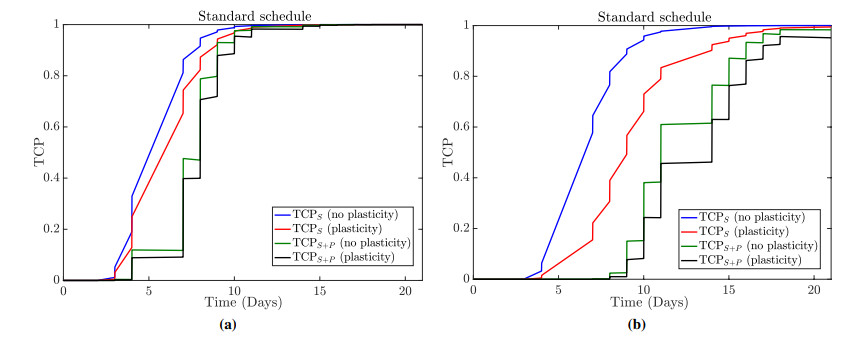









 DownLoad:
DownLoad:
